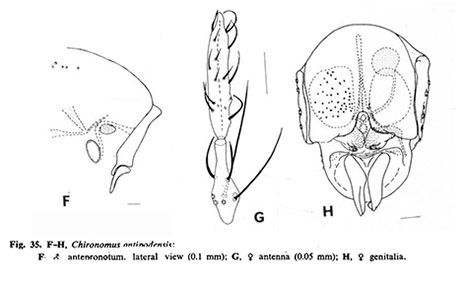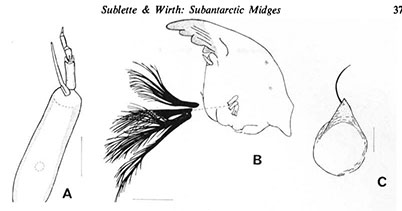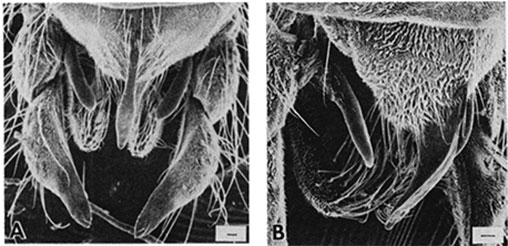13. C. antipodensis Sublette & Wirth, 1980The details of C. antipodensis are included in case the species does occur on the South Island. Adult: Almost entirely blackish brown; haltere, scutellum and narrow posterolateral spot on terga VII and VIII slightly paler. Foretarsus with distinct beard, BR 4.16-6.36. AR 3.86-4.30; LR1 1.26-1.39; LR2 0.55-0.58; LR3 0.61-0.64. Wing length 3.86-5.15 mm, VR 0.96 (S&W use Freeman calculation as 1.04)(see Fig. 36c); cross vein dark brown; 20 setae on squamal fringe. Head: Frontal tubercles 25-31 µm; clypeal width 0.86-0.98 of diameter of antennal pedicel, with 32-62 setae. Palpal proportions (segs 2-5, micron): 76 : 260 : 296 : 316 (holotype). Thoracic setae: Acrostichal - not recorded; Dorsolateral 16-27 in partial double row; Prealar 5-10; Supra-alar 1; Scutellar in partially double staggered row 26-30
About 7 setae on tergite IX, either in individual pale patches or with a few setae in some patches. Anal point narrow at base, Superior volsella almost tubular - not like any of the Strenzke types, closest to a D-type. Inferior volsella about to tip of anal point and to midpoint of the Gonostylus which is quite swollen, reducing over posterior third.  Male pronotum, female A5 and genitalia (Sublette & Wirth 1980) Female: (Allotype) Pupa: Exuvial length 11.7-12.0 mm. Cephalothorax blackish brown; abdomen paler brown. Cephalic tubercles as Fig. C (below);respiratory base (Fig. F, above) moderately constricted in middle, HR about 2. Shagreen of TII coarse and covering middle third of segment; that of TIII-VI covering central half, VII with a small anterolateral patch of fine shagreen on either side of midline; TVIII largely covered by fine shagreen. Respiratory base partly constricted in middle (Fig. 36F, above), HR about 2. Fourth instar larva: a halophilus-type, i.e. some development of posterior Ventral tubules. Head capsule yellowish brown, VHL 0.42-0.43 mm. Mentum (Fig. 36E) appears to be type II-III, with central trifid tooth of type IIA.  Antenna (Fig. A, above) with A1 about 4 times longer than wide; RO about 0.34 up from base, AR about 2. Pecten epipharyngis with about 11 sharp teeth (type 2). Mandible (Fig. B, above) possibly type IIB-C. Cytology: Not known. Found: Antipodes Is.: |
Revised: 23 January 2023
Access: Unrestricted
Copyright © 2021-2023, Jon Martin.
